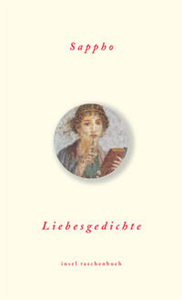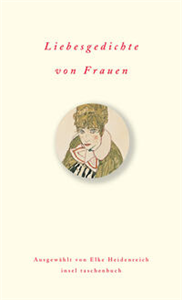Your Search Results
-
Promoted ContentDecember 1989
Sappho
Muse des äolischen Eresos. Neu Übertragen und kommentiert von Stefanie Preiswerk-zum Stein. Mit farbigen Abbildungen
by Sappho, Stefanie Zumstein-Preiswerk
-
Promoted ContentApril 1978
Strophen und Verse
by Sappho, Joachim Schickel, Joachim Schickel
». . . die Sappho-Übertragungen sind hervorragend, weit besser als alles, was mir bisher bekannt wurde. Die Wiedergabe der vorletzten Strophe der Aphrodite-Ode ist eine Zauberei.« KurtWolff
-
 Trusted Partner
January 2007
Trusted Partner
January 2007Liebesgedichte
by Sappho, Joachim Schickel, Marion Giebel, Marion Giebel
»Leuchtender Eros, die Sonne, das Schöne – das habe ich gewählt.« Liebe ist das zentrale Thema in Sapphos Leben – und in ihren Gedichten. Geboren um 600 v. Chr., ist sie die erste Lyrikerin der Weltliteratur. Ihr Gefühl für Gesang, Musik und Poesie was legendär, und sie unterrichtete zahlreiche junge Frauen darin. Ihre Lieder wurden in ganz Griechenland gesungen, Münzen trugen ihr Portrait. Nicht umsonst nannte Platon sie noch zwei Jahrzehnte nach ihrem Tod die zehnte Muse.
-
 Trusted Partner
Literature & Literary StudiesMarch 1999
Trusted Partner
Literature & Literary StudiesMarch 1999Campaspe and Sappho and Phao
John Lyly
by David Bevington, G.K. Hunter
One of a series of play texts by Elizabethan and Jacobean dramatists other than Shakespeare, this volume discusses the plays "Campaspe" and "Sappho and Phao" by John Lyly. The series aims to throw light on the plays and to offer views of the plays that have been neglected in the past. ;
-
 Trusted Partner
Trusted Partner
-
 Trusted Partner
Trusted Partner
-
 Trusted Partner
August 1989
Trusted Partner
August 1989Um zu bleiben
Liebesgedichte. Griechisch und deutsch
by Konstantin Kavafis, Michael Schroeder, Michael Schroeder, David Hockney
Michael Schroeder, geboren 1954 in Trier, studierte Klassische Altertumswissenschaften, forschte in Süditalien, Griechenland und Syrien. Er ist Lektor, Autor und Herausgeber sowie Übersetzer der Gedichte von Konstantinos Kavafis. Zuletzt erschienen: 'Die schönsten Liebesgedichte der Antike' (it 3163) und 'Sappho von Lesbos – Europas erste Dichterin. Biographie' (2008) Michael Schroeder, geboren 1954 in Trier, studierte Klassische Altertumswissenschaften, forschte in Süditalien, Griechenland und Syrien. Er ist Lektor, Autor und Herausgeber sowie Übersetzer der Gedichte von Konstantinos Kavafis. Zuletzt erschienen: 'Die schönsten Liebesgedichte der Antike' (it 3163) und 'Sappho von Lesbos – Europas erste Dichterin. Biographie' (2008)
-
 Trusted Partner
April 2007
Trusted Partner
April 2007Fremdwörterbuchsonette
Gedichte
by Ann Cotten
Mit wenig Assoziationen beschwert; künstlich, neu oder nur vorübergehend im Sprachgebrauch – Fremdwörter scheinen sich für ihre Existenz zu entschuldigen: »Ich erfülle hier nur Begriffsfunktion, habe einen Arbeitsplatz inne, für den es im Moment keinen qualifizierten Deutschen gibt.« Können sie das ernst meinen? Ann Cotten baut sie in die ratternden Denkmaschinen ihrer Gedichte ein: jugendliches Ungestüm im sonettischen Gewand, das klipp und klar Gedachte, die Liebe mit ihren Rückkopplungen. Pete Doherty, Patti Smith und Sappho geistern mit unbekannten DJs und freundlichen Allegorien durch die nächtlichen Verse und wachen am anderen Tag in einem Sprachsubstrat auf, das ihnen ganz fremd vorkommen muß.
-
 Trusted Partner
December 2020
Trusted Partner
December 2020Hälfte des Lebens
Versuch über Hölderlins Poetik
by Winfried Menninghaus
Seit Beginn des 20. Jahrhunderts gelten Hölderlins Gedichte der Jahre 1801-1805 als sein »eigentliches Vermächtnis« – und der Dichter-Priester Pindar als ihr antikes Vorbild. Winfried Menninghaus’ Studie entdeckt in diesen Gedichten einen Komplex von Rhythmen, Themen und mythischen Horizonten, der ihr bislang übersehenes (Anti-)Gravitationszentrum darstellt und zugleich zu einer Revision des dominanten Hölderlin-Bildes zwingt. Die antike Referenz ist dabei nicht Pindar, sondern die Dichterin Sappho. Sapphos Pathographie von erotischen Obsessionen, Trennungssituationen und Erfahrungen des Alterns, so wird gezeigt, ist von herausragender Bedeutung für die Definition dessen, was seit Ende des 18. Jahrhunderts »lyrisch« heißt, und Hölderlin hat einen erheblichen Anteil an dieser Selbstdefinition von »Lyrik« aus einer Beschäftigung mit der Dichterin. Leitfaden der gesamten Studie ist das berühmte Gedicht Hälfte des Lebens, nach dessen Veröffentlichung im Jahr 1804 Hölderlin kein weiteres mehr selbst zum Druck gebracht hat. Die Studie integriert in die Analyse von Hölderlins materialer Arbeit an der Sprache die mythologischen Horizonte des Gedichts, Hölderlins Philosophie der »Schönheit« sowie zentrale Aspekte seiner Theorie der Dichtung.
-
 Trusted Partner
May 2003
Trusted Partner
May 2003Liebesgedichte von Frauen
by Heike Ochs
Dieser Band versammelt Gedichte von über 70 Autorinnen über das eine, unerschöpfliche Thema: die Liebe. Es sind Liebeserklärungen und Abschiedsworte, Bilder von Nähe und Vertrautheit, Anziehung und Abstoßung bis hin zur ekstatischen Feier von Sinnlichkeit und Sexualität. Neben den großen, berühmten Autorinnen von Sappho bis in unsere Zeit – Annette von Droste-Hülshoff, Emily Dickinson, Else Lasker-Schüler, Anna Achmatowa, Marina Zwetajewa, Ingeborg Bachmann, Syvia Plath, Sarah Kirsch (um nur einige wenige zu nennen) – sind auch weniger bekannte Dichterinnen zu entdecken. Immer wieder überraschend die Vielfalt an Themen, Motiven und lyrischen Formen – doch ebenso bemerkenswert ist, bei aller Individualität des Ausdrucks und Erlebens, die Wiederkehr überzeitlicher Konstanten.
-
 Trusted Partner
February 2009
Trusted Partner
February 2009Liebesgedichte von Frauen
by Elke Heidenreich, André Heller
»Ihr kennt ja All’ die Liebe nicht / Die in mir glüht, die in mir stürmt« heißt es in einem Gedicht von Else Lasker-Schüler und »Zur Heimat erkor ich mir die Liebe« bei Mascha Kaléko. Beide Dichterinnen haben ihren Gefühlen in kraftvollen Versen Ausdruck verliehen, ebenso wie viele Dichterinnen vor und nach ihnen. Elke Heidenreich hat die schönsten Liebesgedichte von Frauen für diesen Band ausgewählt, dabei geht es quer durch die Jahrhunderte und um die ganze Welt: von Sappho über Annette von Droste-Hülshoff zu Anna Achmatowa, Ingeborg Bachmann und Wyslawa Szymborska bis hin zu den jungen Stimmen wie Ann Cotten und Silke Scheuermann.
-
 Trusted Partner
March 2008
Trusted Partner
March 2008Türkei
Ein Reisebegleiter
by Barbara Yurtdas
Traumhafte Strände und Buchten und die sprichwörtliche Gastfreundschaft locken jährlich Tausende von Touristen in die Türkei. Doch darüber hinaus gibt es sehr viel mehr zu entdecken: Der Reisebegleiter Türkei lädt ein, das Land, seine faszinierende Kultur und Literatur kennenzulernen. Einheimische und ausländische Autoren begleiten uns auf der Reise durch das Land und erzählen vom Alltag und vom Leben in der heutigen Türkei: Auf dieser abwechslungsreichen Reise begleiten uns Klassiker wie Homer und Sappho ebenso wie Franz Werfel, Christa Wolf, Louis de Bernières, Giorgos Seferis bis hin zu den großen Autoren der türkischen Gegenwartsliteratur - der Nobelpreisträger Orhan Pamuk, Adalet Agaoglu, Bilge Karasu und Mario Levi.
-
 Trusted Partner
Literature & Literary StudiesApril 2009
Trusted Partner
Literature & Literary StudiesApril 2009The female sublime from Milton to Swinburne
Bearing blindness
by Catherine Maxwell
This innovative study of vision, gender and poetry traces Milton's mark on Shelley, Tennyson, Browning and Swinburne to show how the lyric male poet achieves vision at the cost of symbolic blindness and feminisation. Drawing together a wide range of concerns including the use of myth, the gender of the sublime, the lyric fragment, and the relation of pain to creativity, this book is a major re-evaluation of the male poet and the making of the English poetic tradition. The female sublime from Milton to Swinburne examines the feminisation of the post-Miltonic male poet, not through cultural history, but through a series of mythic or classical figures which include Philomela, Orpheus and Sappho. It recovers a disfiguring sublime imagined as an aggressive female force which feminises the male poet in an act that simultaneously deprives and energises him. This book will be required reading for anyone with a serious interest in the English poetic tradition and Victorian poetry. ;
-
 Travel writingAugust 2014
Travel writingAugust 2014Two Cats Walking
by Bettina Selby
For two cats who trace their ancestry back to ancient Egypt , and who believe that they have a sacred duty to the human race, two house moves proves one too many. Deciding that ‘owners’ who drag them away from their home yet again are no longer worthy of them, they escape from their removal vehicle and find themselves adrift somewhere in Middle England with no clear plan of what to do next. Life is suddenly, frighteningly, all tooth and claw, survival of the fittest. Fortunately for the highly articulate but unworldly young cats, they encounter a varied cast of animals who subtly change their outlook on life and help them to realise that they need and want to be back again with their humans, now hundreds of miles away in the mountains of Wales. And so begins their journey, an action packed Odyssey full of surprising shifts and turns hilariously and lyrically related by the two cats. The result is a timeless classic to be enjoyed at any age.
-
 March 2011
March 2011Collected Poems
by James Wright, edited by Anne Wright, Robert Bly
A collection of authentic, profound and beautiful poems.
-
 Poetry by individual poetsMay 2011
Poetry by individual poetsMay 2011The Spaces Between Birds
Mother/Daughter Poems, 1967–1995
by Sandra McPherson
In 1967, Sandra McPherson’s daughter Phoebe was born with Asperger’s Syndrome, a form of autism. Representing 28 years of work, these poems descripe the voyage on which mother and daughter embarked. Interspersed are poems by Phoebe.
-
March 2020
catalien
by Oliver Findlay Price
The title catalien engages with the Surrealist notion of a rebus – a puzzle device that combines images to suggest or depict a new word and requires unexpected creative conjunctions that confuse and then delight when the puzzle resolves itself. The rebus relies on a proliferation of meanings and takes pleasure in both the logical and seemingly illogical. catalien is a mystical debut collection of poems that harnesses a liberal range of human emotions combined with a deceptively charming wickedness. It incorporates a skillful blend of traditional form with free verse; in amongst a terrain of cats, fish, birds, dolphins, lizards and snakes, the poet deftly draws the reader into his idiosyncratic world.
-
 April 2011
April 2011The Branch Will Not Break
Poems
by James Wright
A new book of poetry from a Pulitzer Prize-winning master poet
-
 January 2012
January 2012Collected Poems
by Joseph Ceravolo, edited by Rosemary Ceravolo, Parker Smathers
Long awaited collection of a singular American poet



























